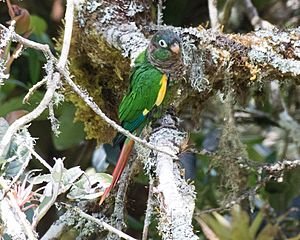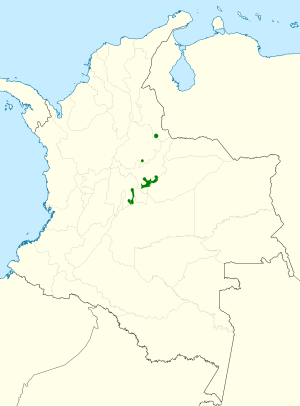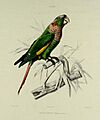Flame-winged parakeet facts for kids
Quick facts for kids Flame-winged parakeet |
|
|---|---|
 |
|
| Conservation status | |
| Scientific classification | |
 |
The flame-winged parakeet (Pyrrhura calliptera), also called the brown-breasted parakeet, is a type of parrot. It lives only in Colombia, in the forest edges and shrubs of the eastern Andean mountains. These birds are found at high altitudes, from about 1,700 to 3,400 meters (5,600 to 11,200 feet) above sea level. Sadly, the flame-winged parakeet is in danger because its home is disappearing.
Contents
What's in a Name?
This parakeet was first described in 1854 by a French bird expert named Charles de Souancé. He called it Conurus callipterus back then.
The name Pyrrhura comes from ancient Greek words. Purrhos means "red" and oura means "tail." So, it means "red-tailed." The second part of its name, calliptera, also comes from ancient Greek. Kallos means "beauty" and pteros means "winged." So, calliptera means "beautiful-winged."
This parakeet is a "monotypic" species. This means there are no different types or subspecies of it.
What Does It Look Like?
The brown-breasted parakeet is a medium-sized bird, about 22 to 23 centimeters (8.7 to 9.1 inches) long. Its throat and upper chest are a medium brown color. The feathers here have light edges, which makes them look like tiny scallops.
Its head is mostly grayish-brown. It has green cheeks and special feathers around its ears that can look reddish or brown. There's a clear white ring around its eye. The lower chest and belly are reddish-brown, often with some green mixed in.
The back of the bird and most of its wing feathers are green. But it has bright yellow feathers on its main wings and bluish feathers on the very tips. Its tail is a dull red. When the parakeet flies, you can see bright yellow and orange-red markings on its wings. This is why it's called the flame-winged parakeet!
Where Does It Live?
The brown-breasted parakeet is found only in Colombia. It used to live in a much larger area. Now, it only lives in small, separate groups on the eastern side of the Eastern Andes mountains.
You can find them in parts of Colombia called Boyacá, Cundinamarca, and Casanare. They might also be in Meta, Santander, and Norte de Santander.
These parakeets live in high mountain forests and forest edges. They prefer places like cloud forests, elfin forests, and subpáramo areas. The groups of parakeets are small and live in very specific spots within these habitats.
How It Lives and Behaves
Raising Young Together
Flame-winged parakeets seem to help each other raise their babies. Groups of 4 to 9 birds work together to care for each set of chicks. These groups include adult birds and younger birds. The younger birds help out, which also teaches them important skills for when they become adults.
These parakeets use holes in trees for sleeping at night and for building their nests. They choose their nesting spots in September. Mating happens during September and October.
On average, a female parakeet lays about 6 or 7 eggs. The eggs are whitish and measure about 21-22 mm wide and 28-29 mm long. The parents mostly sit on the eggs in October and November. It takes about 60 to 70 days for a chick to grow from an egg to a young bird ready to fly. This process is usually finished by January each year.
What Do They Eat?
This parakeet eats fresh and dried fruits, seeds, and parts of flowers from many different native plants. These include plants like Critoniella, Espeletia, Solanaceae, Brunellia, and Miconia.
Sometimes, you can see large groups of them eating grass leaves and seeds in open areas. Brown-breasted parakeets have also learned to eat corn from farms. This can cause problems with farmers.
Its Future
How Many Are Left?
The most recent studies guess there are between 3,300 and 6,700 adult brown-breasted parakeets left. These birds live in separate groups, and none of these groups has more than 1,000 birds. The species has disappeared from areas where it used to live on the western side of the Eastern Andes.
The total number of these birds is going down quickly. Experts don't think this decline will stop soon. Because of this, the species is listed as "Vulnerable" on the IUCN Red List. This list tells us which animals are at risk of disappearing.
What Are the Dangers?
The biggest dangers to the brown-breasted parakeet are habitat loss and habitat fragmentation. This means their cloud forest homes are being destroyed or broken up by new roads and farms.
Pyrrhura parakeets are very sensitive to their habitat being broken into pieces. They don't like to move far from heavily forested areas. This means they can become isolated from other groups of parakeets. The species has lost 75% of its original home. A lot of this loss happened between 2000 and 2010. Since Colombia's population is growing, this problem is expected to continue.
Other dangers are harder to measure. But we know that farmers sometimes see these birds as pests because they eat corn crops. Also, a small number of these birds are caught to be kept as pets, but this is not a major threat.
Helping the Parakeet
Many groups are working to help the flame-winged parakeet. These include national parks, regional environmental groups, and local community groups. However, there isn't one big, organized plan yet.
Some groups are working to restore the natural areas where these birds live. For example, the Aqueduct and Sewerage Company of Bogotá, the Chingaza National Natural Park, and the Sierra Nevada del Cocuy National Park are doing this. In the Sierra Nevada del Cocuy Park, they've created a special "biological corridor." This helps connect different areas of the park and its surrounding zones.
Fundación ProAves, a main group for bird conservation in Colombia, has been studying these parakeets since 2004. They are counting the birds and watching how they reproduce in the Chingaza National Natural Park area. These studies are very important for creating a full plan to save the species.
In a village called Mundo Nuevo, people have put up 48 artificial nest boxes. This is to help make up for the lost tree cavities. Brown-breasted parakeets have been willing to nest in these special boxes.
Images for kids
See also
 In Spanish: Periquito aliamarillo para niños
In Spanish: Periquito aliamarillo para niños




